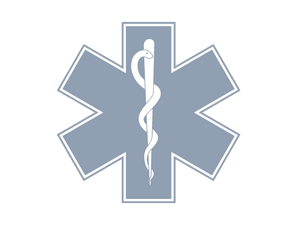
"EMS" stands for Emergency Medical Services which today is a critical component of the nation's emergency, trauma care, and public health systems. EMS is part of the initial stages of the continuum of emergency care which includes emergency calls to 9-1-1; the dispatching of emergency personnel to the scene of an illness or trauma; providing on-scene care; providing care in transit; and transferring patients to definitive care either by ambulance or air medical service.
These functions of the EMS system are represented by each of the bars in the "Star of Life" symbol which was designed by the National Highway Traffic Safety Administration and is now used and recognized world-wide.
 EMS exists in many variations throughout the world. In the United States, our current EMS system has only been around for about the past 50 years. In the beginning, EMS provided little more than first-aid care and it was not uncommon for a mortician and a hearse to provide a patient with transportation to the hospital.
EMS exists in many variations throughout the world. In the United States, our current EMS system has only been around for about the past 50 years. In the beginning, EMS provided little more than first-aid care and it was not uncommon for a mortician and a hearse to provide a patient with transportation to the hospital.
Then in the 1950's and 60's some studies demonstrated that mouth-to-mouth ventilation and cardiopulmonary resuscitation (CPR) were effective at restoring the breathing and circulation of endangered patients. This led to the belief that the rapid response of trained community members to emergency situations would significantly improve the outcomes of patients.
Additionally, in the late 1960's documents such as the Accidental Death and Disability: The Neglected Disease of Modern Society highlighted the "neglected epidemic" – the extraordinary number of people then killed or injured in motor vehicle accidents.
Local communities had already started developing better local EMS projects. Then studies like this and others put additional pressure on the Federal government to reduce the number of injuries and deaths on US highways and to improve emergency care, including the care provided by ambulance services. This led to the creation of the National Highway Safety Bureau now known as NHTSA – the National Highway Traffic Safety Administration, part of the US Department of Transportation.
In the 1970's, EMS was given increased recognition and with strong federal leadership and funding a more sophisticated EMS system was born which included the development of a professional body of emergency medical technicians (EMTs). Today there are several levels of prehospital care providers and attendants including ambulance drivers, first responders, EMTs, paramedics, nurses, and physicians among others.
The Institute of Medicine notes that every year, hundreds of thousands of EMS personnel provide more than 16 million medical transports each year. Each of these transports represents a person for whom the quality of prehospital care, meaning the care given to a patient before or during transportation to a hospital, can make a difference. For some of these patients it is the difference between life and death.
Now prehospital care providers can be found everywhere. They work for private ambulance companies, fire departments, in hospitals, in the mountains, on the beaches, in the military – wherever help is needed. Some prehospital care providers also work as EMS educators and researchers, leading the way in shaping the prehospital care and care providers of tomorrow
Long gone are the days of the "hearse" ambulance. EMS today has taken many forms and variations at the local and state level throughout our nation. It has come a long way and there is still a long road ahead of it to ensure that the challenges in providing the best prehospital care for patients can be met.
Want to find your place in history? Want to make a difference in the lives of others in their time of need? Then consider a career in EMS as a prehospital care provider. You might just be the one to change the future – not only someone else's but your own.
To learn more about the history and current state of EMS in the United States, please visit www.ems.gov and www.nap.edu.
